This year, National Children’s Gardening Week takes place from the 23rd – 31st May. These are our top five ideas for getting kids out in the garden and working on some home grown projects!
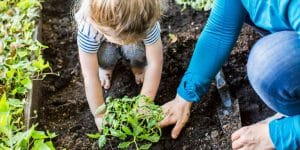
This week is an ideal time to encourage children to enjoy gardening. Copyright Adam Hester/Getty Images.
CREATE A SENSORY AREA OF THE GARDEN
Adding sensory plants to the garden gives children a chance to play and interact more, helping them to learn and gain new knowledge. It’s easy to find interesting plants to look at, but there are also plants with wonderful smells, sounds, tastes and feels! Children are often fascinated by the weird and wonderful and many plants can help achieve this with little fuss.
- Stachys byzantine ‘Big Ears’ – this plant is a real crowd pleaser, with its furry feeling leaves. Children will be fascinated to touch the leaves and discover their strange texture.
- Lemon Balm Melissa officinalis – one for the nose, this perennial herb is lemon scented and produces lovely creamy flowers in Summer. It’s also loved by bees, adding wildlife to the garden and sound to a sensory area. Children will love getting up close and smelling the lemon scent.
- Helichrysum angustifolium – more commonly known as the Curry Plant, Helichrysum angustifolium has glorious aromatic foliage with beautiful silver leaves. It’s easy to grow and likes a sunny location in the garden. Children will be fascinated by its smell.
- Griselinia littoralis
This plant provides excellent evergreen screening, but also has a lovely silky soft feel to its leaves. Children will be attracted to the glossy leaves and will love touch.
- Fargesia nitida ‘Black Pearl’
This amazing, clump forming bamboo has attractive dark canes and is also ideal for containers or smaller gardens. When the breeze moves through the foliage, it creates a relaxing rustling sound.
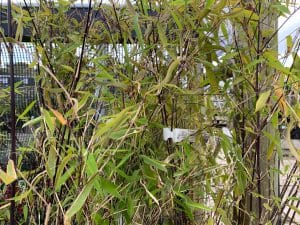

Fargesia nitida at Coolings
MAKE A MINI ALLOTMENT
Mini allotments are easy to make and allow vegetables to be grown all year round! Kids will love them as they can see the results of their work quite quickly. Start by ensuring that you have a suitable container, such as old plastic pots or plastic trays. Your container needs to have drainage holes. If it has open sides (such as a crate) then line it to stop the compost falling out – remember to add holes in this too to ensure drainage. Then follow these steps!
- Add compost to your container and level it out. This can be done with a ruler or can be patted down with hands!
- Choose your micro seeds and plant them as instructed on the packet! They can be planned closer together than recommended as this is a mini allotment.
- Make sure that the seeds are labelled, using a maker such as an ice cream stick.
- Water the mini allotment outside and then bring it inside and place on a sunny windowsill.
- Check it regularly (this could be a daily job for a child) and water when the compost is dry. Crops should be ready to harvest after 15 to 25 days!
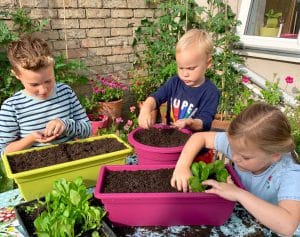

Making a mini allotment can help to teach children about how food is grown and can encourage them to eat their 5-a-day. Image from Wilko.
SOW SUNFLOWER SEEDS IN POTS
Sunflowers are a brilliant choice to grow with children. It teaches them about how to plant and care for seeds, and sunflowers are interesting plants for children to look at with all their details! They are especially enjoyable if they grow very tall. To start with you will need some pots, compost and your sunflower seeds.
- Add compost to the pot and then make a hole in the middle of the compost with your finger. The hole should be around 2cm deep.
- Place a sunflower seed into the hole and cover with compost.
- Make sure that it is labelled and then water it enough to make the compost moist. Move it to a sunny windowsill and ensure that the pot has enough water to keep it moist.
- Harden off before moving them outside permanently. Take them outside in the day time and then bring them in again at night. This is a great job for the kids to do and gives them some responsibility!
- Once hardened off, you can plant your seedlings outside and watch them grow!
Shop vegetable plants here. Please note these are not all suitable for growing in a mini allotment.


Sunflowers are ideal for growing with children as they are easy and educational to grow. Image from Pixabay.
GET CREATIVE MAKING SIGNS AND LABELS
This is a great task for keeping the garden organised and for getting children to be creative! Children can use a range of materials and designs to create plant labels which are appealing and informative. Pictures of the plant could also be printed or drawn out and put on the labels, so children can see what is growing!
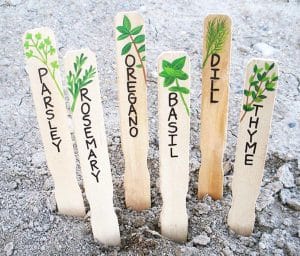

Create some creative plant markers, such as these ones from Sustainable Simplicity.
MAKE A BUG HOTEL
Lots of gardens are very tidy and we often move things where bugs might make their nests or escape from bad weather. Creating a bug hotel gives these creepy crawlies a place to live and brings wildlife back into your garden. The ideal bug hotel will have lots of spaces inside, and can be dry or damp, depending on what you are trying to attract. Many different materials can be used to build them – why not start but seeing what you already have in your garden to use?
Animals that might visit your bug hotel include bees, woodlice, spiders, centipedes, ladybirds and more!
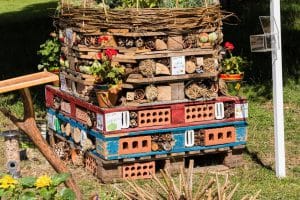

A great example of bug hotel! Image from www.kebur.co.uk
For more ideas about what to do this National Children’s Gardening Week, head over to our Facebook Page.







